Wedding of Willem-Alexander, Prince of Orange, and Máxima Zorreguieta Cerruti
The wedding of Willem-Alexander, Prince of Orange and Máxima Zorreguieta Cerruti took place on 2 February 2002 at the Nieuwe Kerk, Amsterdam. Willem-Alexander and Máxima acceded to the Dutch throne on 30 April 2013 after the abdication of his mother, Queen Beatrix.
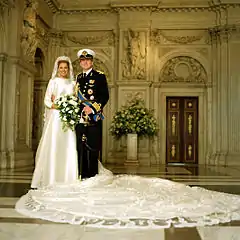 Willem-Alexander and Máxima on their wedding day | |
| Date | 2 February 2002 |
|---|---|
| Location | Beurs van Berlage Nieuwe Kerk, Amsterdam |
| Participants | Willem-Alexander, Prince of Orange Máxima Zorreguieta Cerruti |
Engagement
Willem-Alexander, Prince of Orange, eldest son and heir of Queen Beatrix and Prince Claus, met Argentine-born Máxima Zorreguieta Cerruti at the Seville Fair in April 1999. He did not introduce himself as a prince, and when she later found out, she thought he was joking. Two weeks later, they met again in New York, where Máxima was working as a banker for Kleinwort Benson. She did not meet his parents, Queen Beatrix and Prince Claus, for some time.[1]
As speed skating is one of the most popular sports, and Willem-Alexader is a good speed skater, he proposed to Máxima on the ice on skates. A week earlier, Willem-Alexander already told his mother and Prime Minister Kok that he would propose to Máxima soon. He endlessly practices the question, he told in an interview later. With hidden champagne and red roses by the pond of Huis ten Bosch, he invited Máxima to go ice skating. While on the ice of the pond he proposed her in English, "to make sure she would understand it". Máxima was surprised but answered directly with "yes".[2][3]
The intention was that the intended marriage remained a secret, so as not to get in the way of Willem-Alexander's brother Constantijn and Laurentien Brinkhorst, who would marry in May. Ultimately, it was too difficult to keep secret, so on 30 March 2001, Queen Beatrix announced her eldest son's engagement. On 21 May 2001, the bill seeking consent for the marriage was introduced in parliament. On 7 January 2002, the ondertrouw was published.[4]
Zorreguieta became a naturalized Dutch citizen, though she did not convert from Roman Catholicism. It was announced any children born of the marriage would be titled Prince/Princess of the Netherlands and Prince/Princess of Orange-Nassau, with the style of Royal Highness.
Controversy
During the National Reorganization Process, Argentina's most recent dictatorship, Jorge Zorreguieta, Máxima's father, served as Secretary of Agriculture, Livestock, and Fisheries. During this regime, an estimated 10,000–30,000 people were kidnapped and murdered during this and subsequent military regimes before democracy was restored to Argentina in 1983. Zorreguieta claimed he was unaware of the Dirty War while he was a cabinet minister.
At the request of the States General, Michiel Baud, a Dutch professor in Latin American studies, carried out an inquiry into the involvement of Zorreguieta in the Dirty War. Baud determined that Máxima's father had not been directly involved in any of the numerous atrocities that took place during that period. However, Baud also concluded that Zorreguieta was almost certainly aware of them; in Baud's view, it was highly unlikely that a cabinet minister would not have known about them.[5]
Jorge Zorreguieta's presence at the wedding was debated for months. It was eventually concluded he would not attend. In solidarity, her mother chose not to attend.
Pre-wedding celebrations
On 31 January, Queen Beatrix's 64th birthday, there was a black-tie dinner and ball at the Royal Palace of Amsterdam for 500 guests to celebrate the impending wedding and The Queen's birthday.
The day before the wedding, there was a lunch and concert at the Royal Concertgebouw attended by 1,600 guests. That evening, the couple attend an event organized by the National Orange Committee and the municipality of Amsterdam in the Amsterdam ArenA. About 50,000 people from every Dutch municipality were invited.[6]
Wedding
Civil ceremony
Per Dutch law, the couple were first required to be married in a civil ceremony. This was performed by Job Cohen, Major of Amsterdam, at the Beurs van Berlage prior to the religious ceremony. The civil ceremony was attended by friends and family of the couple, dignitaries and some 600 invited guests.[4]
Witnesses for the Prince of Orange were his brother, Prince Constantijn, and friends Marc ter Haar and Frank Houben. Witnesses for Zorreguieta Cerruti were her new mother-in-law, Queen Beatrix, her aunt, Marcela Cerruti Carricart, and her brother, Martín Zorreguieta Cerruti.
Religious ceremony
The Dutch Reformed Church ceremony took place in the Nieuwe Kerk, Amsterdam. The Reverend Carel ter Linden, Minister Emeritus of the Kloosterkerk, The Hague, officiated.[4]
Music
Music during the service was provided by Bernard Winsemius, organist, Miranda van Kralingen, soprano, the Nederlands Kamerkoor and the Royal Concertgebouw Orchestra, conducted by Ed Spanjaard.[6]
Prior to the service, pieces by Böhm, Bach and Scheidemann were played on the organ. The bride and groom entered the church together to Entrata Festiva, which was composed by Dutch composer Jurriaan Andriessen for the wedding of Prince Willem-Alexander's parents in 1966. Throughout the service, a number of Dutch hymns were sung. Kyrie from Mozart's Mass in C major, K. 337 "Solemnis" and Schubert's Ave Maria were also performed. The recessional was "Hallelujah" from Handel's Messiah.
In honour of the bride's parents, who were absent, Adiós Nonino, an Argentine tango by Astor Piazzolla was played.[7]
Attendants
The bride was attended by four adult bridesmaids:
- Valeria Delger, the bride's childhood friend
- Juliana Guillermo, the groom's maternal first cousin
- Baroness Theresa von der Recke, the groom's paternal first cousin
- Inés Zorreguieta, the bride's sister
Two child bridesmaids:
- Princess Pauline of Sayn-Wittgenstein-Hohenstein
- Countess Leonie of Waldburg-Zeil-Hohenems
Four pageboys:
- Jonkheer Paulo Alting von Geusau
- Baron Johann-Casper von dem Bussche-Haddenhausen
- Mr Alexandre Friling
- Mr Floris ter Haar
Clothing
The bride wore a gown of ivory mikado silk, with a cowl neckline, three-quarter sleeves and a five-metre-long train designed and created by Valentino. The skirt was inset with panels of embroidered lace at the sides, flaring slightly from a close-fitting empire-line bodice.[4] Her veil, also a Valentino creation, was of silk tulle and hand-embroidered with a flower and tendril motifs. The court jeweller adapted the Dutch Pearl Button Tiara by exchanging the pearl buttons with five diamond stars which belonged to Queen Emma.[6] The bride carried a cascading bouquet of white roses, gardenias, lilies of the valley and two kinds of foliage.[6]
The Prince wore the full dress uniform of a Captain in the Royal Netherlands Navy. He wore the riband and star of a Knight Grand Gross of the Order of the Netherlands Lion, the star of a Knight of the Order of the Gold Lion of the House of Nassau, the Officers' Cross and the Queen Beatrix Inauguration Medal, 1980.[4]
Procession and reception
After the service, the bride and groom drove through the Nieuwezijds Voorburgwal, Spui, Singel, Muntplein and the Rokin in the Golden Coach.[4] The couple then returned to the Royal Palace and appeared on the balcony above Dam Square. They then proceeded to a luncheon reception.
Guests
House of Orange-Nassau
- The Queen and Prince Consort, the groom's parents
- Prince Friso, the groom's brother
- Prince Constantijn and Princess Laurentien, the groom's brother and sister-in-law
- Prince Bernhard, the groom's maternal grandfather
- Princess Irene, the groom's maternal aunt
- The Prince of Piacenza, the groom's first cousin
- The Count of Bardi, the groom's first cousin
- The Marchioness of Sala, the groom's first cousin
- Princess Margriet and Mr Pieter van Vollenhoven, the groom's maternal uncle and aunt
- Prince Maurits and Princess Marilène of Orange-Nassau, van Vollenhoven, the groom's first cousin and his wife
- Prince Bernhard and Princess Annette of Orange-Nassau, van Vollenhoven, the groom's first cousin and his wife
- Prince Pieter-Christiaan of Orange-Nassau, van Vollenhoven, the groom's first cousin
- Prince Floris of Orange-Nassau, van Vollenhoven, the groom's first cousin
- Princess Christina, the groom's maternal aunt
- Mr Bernardo Guillermo, the groom's first cousin
- Mr Nicolás Guillermo, the groom's first cousin
- Miss Juliana Guillermo, the groom's first cousin (bridesmaid)
- Princess Irene, the groom's maternal aunt
House of Amsberg
- Jonkvrouw Sigrid Jencquel, the groom's paternal aunt
- Mr and Mrs Joachim Jencquel, the groom's first cousin and his wife
- Baroness Theda and Baron Karl von Friesen, the groom's paternal aunt and uncle
- Baron Alexander von Friesen, the groom's first cousin
- Baroness Renate von Friesen, the groom's first cousin
- Baroness Isabell von Friesen, the groom's first cousin
- Baroness Christina and Baron Hans von der Recke, the groom's paternal aunt and uncle
- Baroness Katinka von der Recke, the groom's first cousin
- Baroness Sophie von der Recke, the groom's first cousin
- Baroness Theresa von der Recke, the groom's first cousin (bridesmaid)
Relatives of the bride
Due to the controversy surrounding her father's alleged involvement in Argentina's Dirty War, the bride's father, Jorge Zorreguieta, was not invited. In solidarity with her husband, the bride's mother, María del Carmen Cerruti Carricart, chose not to attend.
- Mr and Mrs Martín Zorreguieta Cerruti, the bride's brother and sister-in-law
- Mr Juan Zorreguieta Cerruti, the bride's brother
- Miss Inés Zorreguieta Cerruti, the bride's sister (bridesmaid)
- Mrs María and Mr Adrián Vojnov, the bride's half-sister and brother-in-law
- Miss Ángeles Zorreguieta López Gil, the bride's half-sister
- Mrs Dolores and Mr Harmond Grad Lewis, the bride's half-sister and brother-in-law
- Mrs Marcela Cerruti Carricart, the bride's maternal aunt
Members of reigning royal houses
.svg.png.webp) The King and Queen of the Belgians
The King and Queen of the Belgians
 The Queen of Denmark
The Queen of Denmark
 The Crown Prince of Japan (representing the Emperor of Japan)
The Crown Prince of Japan (representing the Emperor of Japan)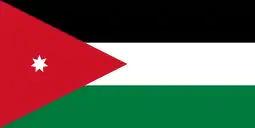 Queen Noor of Jordan (representing the King of Jordan)
Queen Noor of Jordan (representing the King of Jordan) Prince Hassan bin Talal and Princess Sarvath al-Hassan of Jordan
Prince Hassan bin Talal and Princess Sarvath al-Hassan of Jordan
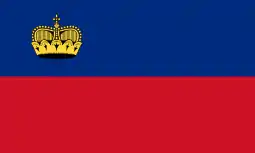 The Hereditary Prince and Hereditary Princess of Liechtenstein (representing the Prince of Liechtenstein)
The Hereditary Prince and Hereditary Princess of Liechtenstein (representing the Prince of Liechtenstein) The Grand Duke and Grand Duchess of Luxembourg
The Grand Duke and Grand Duchess of Luxembourg
 Grand Duke Jean and Grand Duchess Joséphine Charlotte of Luxembourg
Grand Duke Jean and Grand Duchess Joséphine Charlotte of Luxembourg
 Prince Guillaume and Princess Sibilla of Luxembourg
Prince Guillaume and Princess Sibilla of Luxembourg
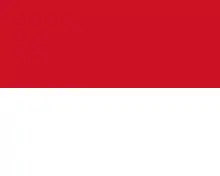 The Hereditary Prince of Monaco (representing the Prince of Monaco)
The Hereditary Prince of Monaco (representing the Prince of Monaco) Prince Moulay Rachid of Morocco (representing the King of Morocco)
Prince Moulay Rachid of Morocco (representing the King of Morocco) The King and Queen of Norway
The King and Queen of Norway
 The Queen of Spain (representing the King of Spain)
The Queen of Spain (representing the King of Spain)
 The King and Queen of Sweden
The King and Queen of Sweden
 The Prince of Wales (representing the Queen of the United Kingdom)
The Prince of Wales (representing the Queen of the United Kingdom) The Earl and Countess of Wessex
The Earl and Countess of Wessex
Members of non-reigning royal houses
 The Aga Khan and Begum Aga Khan
The Aga Khan and Begum Aga Khan The Prince and Princess of Turnovo
The Prince and Princess of Turnovo.svg.png.webp) King Constantine II and Queen Anne-Marie of the Hellenes
King Constantine II and Queen Anne-Marie of the Hellenes
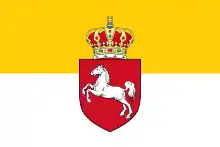 The Prince and Princess of Hanover
The Prince and Princess of Hanover Prince Philipp of Hesse
Prince Philipp of Hesse The Duke of Parma, ex-husband of the groom's maternal aunt
The Duke of Parma, ex-husband of the groom's maternal aunt.svg.png.webp) The Prince and Princess of Sayn-Wittgenstein-Berleburg
The Prince and Princess of Sayn-Wittgenstein-Berleburg
.svg.png.webp) The Prince and Princess of Sayn-Wittgenstein-Sayn
The Prince and Princess of Sayn-Wittgenstein-Sayn.svg.png.webp) The Prince and Princess of Waldeck and Pyrmont
The Prince and Princess of Waldeck and Pyrmont
Dutch politicians
Foreign politicians
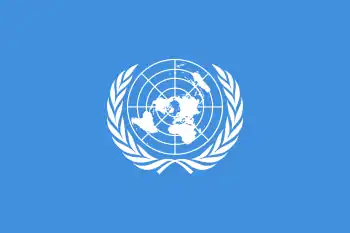 Nane and Kofi Annan, Secretary-General of the United Nations and his wife
Nane and Kofi Annan, Secretary-General of the United Nations and his wife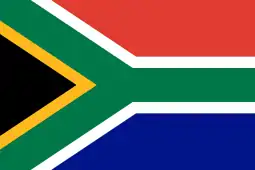 Nelson Mandela and Graça Machel, former President of South Africa and his wife
Nelson Mandela and Graça Machel, former President of South Africa and his wife.svg.png.webp) James Wolfensohn, President of the World Bank Group
James Wolfensohn, President of the World Bank Group
Other notable guests
- Valentino Garavani, designer of the bride's gown
Aftermath
Per a decree issued on 25 January 2002, upon the solemnization of marriage, Máxima became formally titled "Her Royal Highness Princess Máxima of the Netherlands, Princess of Orange-Nassau, Mrs. van Amsberg."[8] She did not, however, become Princess consort of Orange.
The newlyweds honeymooned in St. Moritz, after a brief layover in London to visit with the bride's parents. They then proceeded to Argentina and New Zealand.
The couple have three children, Catharina-Amalia, Alexia and Ariane.
References
- "Princess Maxima". Hello magazine. Archived from the original on 21 April 2016. Retrieved 1 May 2020.
- "Zó vroeg koning Willem-Alexander koningin Máxima ten huwelijk". Libelle TV.
- "Willem-Alexander vertelt over zijn huwelijksaanzoek aan Máxima (2002)". nos.nl.
- "Royal wedding". Royal House of the Netherlands. Retrieved 1 May 2020.
- Human rights: Zorreguieta vs.humanrights Archived 19 January 2009 at the Wayback Machine, March 2001.
- Leistra, Netty. "The wedding of the Prince of Orange and Máxima Zorreguieta". Netty Royal. Retrieved 6 May 2020.
- "Máxima vertelde bandoneonspeler CAREL KRAAYENHOF: "Ik ben verliefd op de tango en Piazzolla"". De Telegraaf (in Dutch). 2 February 2002.
- Decree of 25 January 2002 laying down the titles and styles of Máxima Zorreguieta and titles, names, and styles of the children who might be born from the marriage of His Royal Highness Prince Willem-Alexander Claus George Ferdinand, Prince of Orange, Prince of the Netherlands, Prince of Orange-Nassau, Jonkheer van Amsberg with Her Royal Highness Princess Máxima of the Netherlands, Princess of Orange-Nassau, Mrs van Amsberg Archived 28 September 2013 at the Wayback Machine. Official Gazette of the Kingdom of the Netherlands. No. 41. Published: 31 January 2002